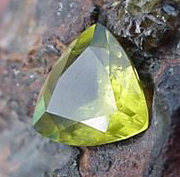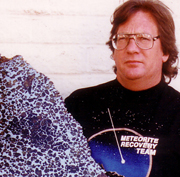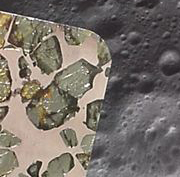Official Name:
Esquel is the name of the village where this meteorite was discovered.
Location:
Esquel is in the province of Chabut, in Patagonia, Argentina.
Fall or Find:
Find
Date:
1951
Mass Recovered:
Specialists suggested widely different masses for the Esquel meteorite. Many spoke of recovering approximately 1 500 kilograms of meteoritic material, while others said 680 kilograms. Today, the mass of 680 kilograms is considered more likely. There was apparently some confusion between the units of measure: 1 500 pounds is the exact equivalent of 680 kilograms.
Thus, contrary to what is written in a number of works, Esquel is not the third largest stony-iron meteorite.
Number of Fragments:
Only one fragment of this meteorite has been found. It is over one metre long.
Circumstances:
Esquel was buried in the ground when it was discovered by chance. A farmer found the meteorite when he was digging a pond for his livestock.
History:
The main mass remained in the possession of the man who discovered it until the spring of 1992. Then collector Robert Haag acquired it for $200 000 (US). Haag had a slice cut off the meteorite for himself. More than 1 metre long by 35 centimetres high and 5 millimetres thick, it is the largest slice of Esquel. The cut took two weeks of work!
Since the meteorite was purchased by Haag, pieces of it have been distributed and sold to numerous museums, science institutes, universities, and collectors.

Enlargement
This superb faceted peridot is from the Esquel pallasite. It is very rare to find such a large, unshocked gem in a meteorite. |
|

Enlargement
Mark Carlton with the slice of the Esquel pallasite that he cut from the main mass for a famous collector. |
|
Type:
Stony-iron meteorite
Group:
Pallasite
Composition:
This chondrite is composed essentially of olivine and pyroxene. Its total iron content accounts for 19.22% of its volume.
In addition to olivine (66%), iron (23.5%), and nickel (8.5%), the accessory minerals in this meteorite are schreibersite (0.76%), troilite (0.46%), and chromite (0.31%). These silicates are concentrated in the boundary regions between the grains of olivine and the metallic matrix.

Enlargement
The Esquel pallasite contains rounded fragments of silicates. It comes from the mantle of a differentiated asteroid. |
|
Scientific contribution:
There are very few small olivine crystals in this pallasite. Yet the parent body must have endured several impacts during its history. Scientists believe that the small fragments broken by the impacts fused together during subsequent increases in temperature.
Comments:
Many people describe Esquel as the most beautiful meteorite in the world. Although the uncut main mass is not very attractive, the polished slices are breathtakingly beautiful.
Part of the Planétarium's collection:
Yes